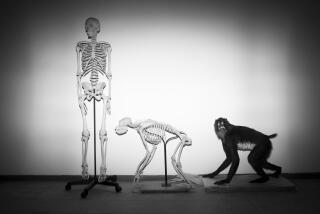The Brambly Bush of Life
- Share via
One chauvinistic premise underlying classroom charts of evolution is that the more human a creature looks, the smarter it must be. Classical paleontology has held that primates became bipedal and lost simian features, like a protruding mid-face and jaws, at about the same time they developed large brains and began to use tools.
That premise came into question in 1974 when Donald Johanson discovered a 3.2-million-year-old skeleton dubbed Lucy, Australopithecus afarensis, which stood upright but had a pint-size brain.
Now a paper by Meave Leakey, daughter-in-law of fossil hunters Louis and Mary Leakey, once again undermines the parochial assumption that human features connote intelligence.
The paper, published in last week’s issue of the journal Nature, describes a 3.5-million-year-old skull of a new species, Kenyanthropus platyops, or the flat-faced man of Kenya, that combines remarkably human features like vertical cheeks and small molars with a chimpanzee-size brain.
Leakey’s discovery also adds to a growing body of evidence that Lucy’s species, once thought to be the direct forebear of modern humankind, was probably not alone on the African plateau. Other fossil finds in the last decade have made it clear that Homo erectus overlapped in time with Homo sapiens and that australopithecines like Lucy coexisted and perhaps even interbred with early Homo in southern and eastern Africa.
The human family tree, once drawn with a trunk straight and true, is looking more like a brambly bush, with branches tangling upon one another.
Paleontologists had hopes that the human genome project would help them untangle the thicket. But when geneticists completed a rough draft of the human genome last year, it too looked less like a tree than a bush. While some geneticists had expected to find a neat procession of genes, each one coding for a protein that accomplishes a specific task like building a body part, they instead discovered an unruly party wherein genes interact with one another, producing dozens of different proteins depending on the environment they find themselves in.
The discoveries have led geneticists like Harvard’s George M. Church to call for a “probabilistic” rather than deterministic science of genetics that tries to calculate odds rather than draw absolute lines of cause and effect.
Similarly, a school of archeology called cladistics argues that attempts to chart precise links between species are more storytelling than science because they force scientists to make unfounded generalizations to fill in a very patchy fossil record. Cladistics urges archeologists to move away from the classical archeological goal of showing through a bone record how one species evolved into another and focus instead on grouping living things by their shared characteristics.
This new school of thought acknowledges something inherent in Leakey’s and Johanson’s discoveries and the human genome project: that while our knowledge of human development grows daily, meeting our direct ancestors may be an impossible dream.





